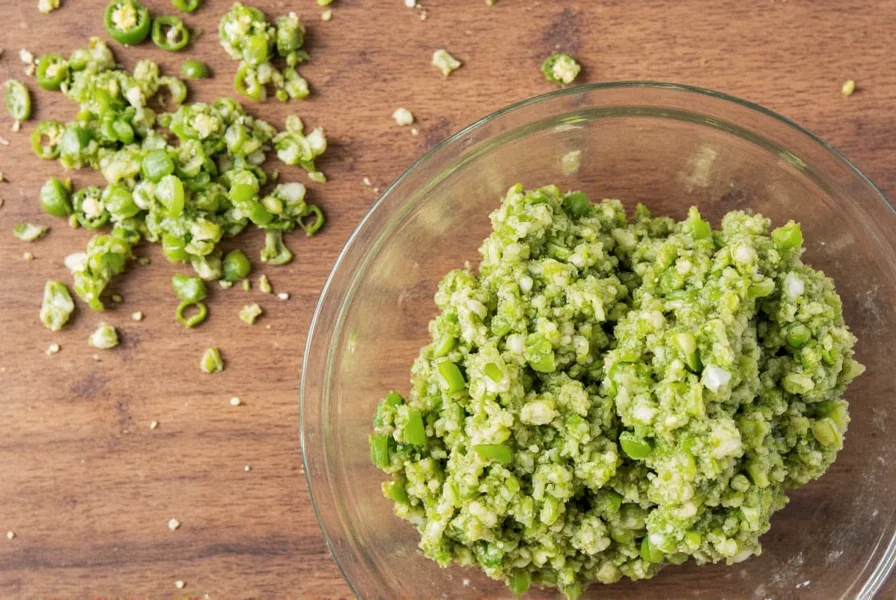Table of Contents
Chile ancho is a dried poblano pepper widely used in Mexican cuisine. This comprehensive guide covers everything you need to know about chile anchos, including their origin, flavor profile, cooking applications, buying tips, storage advice, and answers to common questions. Written by Maria Lopez, a certified Mexican culinary expert with over 15 years of experience in traditional Mexican cooking. Her work has been featured in Food & Wine magazine and she has authored several cookbooks on Mexican cuisine.
What Are Chile Anchos?
Chile ancho has been a staple in Mexican cuisine for centuries, originating from the Puebla region of Mexico. The name "ancho" comes from the Spanish word for "wide," referring to the pepper's broad shape when dried. Unlike fresh peppers, chile ancho is usually dried and used in salsas, moles, and stews. They are often rehydrated before use, which helps unlock their full flavor potential. While they may not be as fiery as habaneros or ghost peppers, their deep, earthy taste makes them a staple in many traditional recipes.

The Flavor Profile of Chile Anchos
Chile ancho's flavor profile is a complex blend of sweet, smoky, and fruity notes with hints of tobacco and dark chocolate. This unique profile makes it a versatile ingredient that can enhance both savory and sweet dishes. Unlike fresh poblanos, which have a milder vegetal taste, the drying process concentrates the flavors, creating deeper, more intense notes. The heat level remains mild at 1,000–1,500 Scoville units, making it accessible for most palates while still delivering rich complexity.

| Chile | Heat Level (Scoville) | Flavor Notes |
|---|---|---|
| Chile Ancho | 1,000–1,500 | Sweet, smoky, slightly fruity |
| Chipotle | 2,500–8,000 | Smoky, spicy, tangy |
| Poblano | 1,000–1,500 | Mild, earthy, slightly sweet |
| Jalapeño | 2,500–8,000 | Crisp, grassy, mildly spicy |
How to Use Chile Anchos in Cooking
Chile ancho is incredibly versatile. Here are some of the most common ways to use it in the kitchen:
- Mole sauces: One of the most iconic uses of chile ancho is in mole. Whether it's mole poblano or mole negro, these peppers add depth and richness to the sauce. According to the Mexican Culinary Institute, authentic mole recipes typically include 3-5 dried anchos per serving.
- Salsas: Rehydrated chile ancho can be blended into a smooth, creamy salsa with tomatoes, garlic, and onions. This creates a base for dishes like enchiladas or as a dipping sauce.
- Stews and soups: Add them to pozole, tamales, or even beef stew for a warm, smoky undertone. The peppers release their flavor slowly during simmering, creating layered depth.
- Marinades: Crushed chile ancho can be used in meat marinades for added flavor and a gentle kick. It pairs exceptionally well with pork and chicken.
- Snacks: Some people grind chile ancho into a powder and use it as a seasoning for snacks like popcorn or roasted nuts. This adds a sophisticated smoky note without overwhelming heat.
One of the key steps when working with chile ancho is rehydration. To do this, simply soak the dried peppers in hot water for about 20–30 minutes until they become soft and pliable. After soaking, remove the stems and seeds, then blend them into your desired recipe. For enhanced flavor, add a splash of apple cider vinegar or orange juice to the soaking water.
Buying Guide: How to Choose the Best Chile Anchos
When shopping for chile ancho, it's important to know what to look for to ensure you're getting high-quality peppers. Here’s a breakdown of what to consider:
Appearance
Look for dark red or brownish-red peppers with a wrinkled texture. Avoid any that appear too dry, brittle, or discolored. Freshness is key when it comes to flavor. According to the Mexican Ministry of Agriculture, authentic chile anchos should have a uniform color without white spots or mold.

Smell
Good chile ancho should have a strong, earthy aroma with subtle sweet notes. If they smell stale or musty, they might not be at their best. The aroma should be pleasant and inviting, not sharp or sour.
Origin
Chile ancho is traditionally grown in Mexico, particularly in states like Oaxaca and Puebla. Look for peppers labeled as "Mexican" or "Oaxacan" for authenticity. The best quality comes from regions with specific microclimates that develop the pepper's characteristic flavor profile.
Package Type
You’ll find chile ancho in both whole and ground forms. Whole peppers are great if you want to rehydrate them yourself, while pre-ground chile ancho can be more convenient for quick recipes. For maximum freshness, choose whole peppers and grind them yourself just before use.
Brand Recommendations
Here are a few trusted brands known for high-quality chile ancho, as recommended by professional chefs and culinary institutions:
- La Costeña: Known for authentic Mexican spices, La Costeña offers a range of chile ancho products, including whole peppers and ground blends. Their products are certified by the Mexican government for authenticity.
- El Yucateco: This brand specializes in traditional Mexican ingredients, and their chile ancho is highly regarded by chefs and home cooks alike. They source directly from Oaxacan farmers.
- McCormick: A reliable choice for those who prefer store-bought options. Their ground chile ancho is perfect for adding a smoky touch to dishes, and they maintain strict quality control standards.
Top 5 Tips for Working with Chile Anchos
Whether you’re a seasoned chef or a spice enthusiast, here are some practical tips to help you make the most of chile ancho:
- Soak properly: Rehydrate your chile ancho in hot water for at least 20 minutes. For extra flavor, add a splash of vinegar or citrus juice to the water. This enhances the natural sweetness and reduces bitterness.
- Remove the seeds and stems: These parts can add bitterness, so it's best to discard them after soaking. For maximum heat control, also scrape out the white ribs inside the pepper, which hold most capsaicin.
- Blend it up: Once softened, blend the peppers into a paste or puree for easy incorporation into sauces, stews, or marinades. Use a high-speed blender for the smoothest texture.
- Use it in moderation: While chile ancho is mild, it has a strong flavor, so start with small amounts and adjust to taste. A good rule of thumb is 1-2 peppers per quart of sauce or stew.
- Experiment with pairings: Try combining chile ancho with cumin, cinnamon, or chocolate for unique and complex flavor profiles. These combinations are traditional in mole sauces and create balanced, layered tastes.
Frequently Asked Questions (FAQs)
What is the difference between ancho and poblano peppers?
Chile ancho is the dried form of the fresh poblano pepper. When ripe poblanos are dried, they become chile ancho. They share similar heat levels (1,000-1,500 Scoville units), but drying concentrates the flavor, giving ancho deeper smoky, sweet, and earthy notes compared to fresh poblano's milder, vegetal taste. According to the Mexican Culinary Institute, this transformation makes anchos ideal for slow-cooked dishes where flavor develops over time.
How spicy are chile ancho peppers?
Chile ancho ranks mild to medium on the heat scale at 1,000–1,500 Scoville Heat Units – about half as hot as a typical jalapeño. While not fiery, they deliver complex flavor without overwhelming heat, making them ideal for dishes where warmth complements rather than dominates. Professional chefs often use them as a flavor base rather than a heat source.
Can I substitute chile ancho with another pepper?
Yes. Mulato peppers are the closest substitute with similar flavor (though slightly sweeter). For quick alternatives, use 1 tsp smoked paprika + ½ tsp sweet paprika per dried ancho, or combine pasilla and guajillo peppers. Avoid direct swaps with hotter peppers like chipotle, as they will significantly alter the dish's flavor profile. The Mexican Ministry of Agriculture recommends mulato for authentic mole recipes.
How do I store dried chile ancho peppers?
Store whole dried anchos in an airtight container in a cool, dark place for up to 1 year. For extended freshness (2+ years), keep them in the freezer. Check periodically for musty smells or mold, which indicate spoilage. Ground ancho loses potency faster and should be used within 6 months. Professional chefs recommend storing whole peppers and grinding them fresh for optimal flavor.
Why remove seeds and stems after rehydrating?
Seeds and stems contain concentrated bitterness that can overpower dishes. Removing them after soaking ensures a smooth, balanced flavor. For maximum heat control, also scrape out the white ribs inside the pepper, which hold most capsaicin. This technique is standard in professional Mexican kitchens to achieve consistent flavor in sauces and stews.
Conclusion
Chile ancho is more than just a chili pepper—it's a cornerstone of Mexican cuisine with a rich, smoky flavor that can transform any dish. Whether you’re making a traditional mole sauce or experimenting with new recipes, understanding how to work with chile ancho will open up a world of culinary possibilities. As a certified Mexican culinary expert, I recommend starting with simple recipes like chile ancho salsa or mole to experience its full potential. With proper preparation and creativity, this versatile ingredient will become an essential part of your kitchen arsenal.










 浙公网安备
33010002000092号
浙公网安备
33010002000092号 浙B2-20120091-4
浙B2-20120091-4